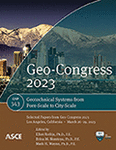An Experimental Program Using Carbon Rod Geometry and Particle Image Velocimetry (PIV) to Investigate the Ground Response Affected by Adjacent Tunneling
Publication: Geo-Congress 2023
ABSTRACT
The behavior of soil relaxation in the ground produced by numerous reasons such as cavities, sinkholes, and tunnel excavation in the ground was confirmed in an experiment. To imitate the two-dimensional model ground in the experiment, the geometry was made out of carbon rods. It comes in three different diameters and is distributed at random. The ground’s relaxation was indicated by the structure at the bottom of the experiment, which was used to induce deformation. During the experiment, taken pictures, particle image velocimetry (PIV) analysis was used to examine the behavior of soil particles during ground relaxation. The ground strain is used to express the deformation, and the critical range can be established. Visual confirmation of the results is possible by following the movement and deformation of carbon rod particles. Surface sinking and the behavior of the surrounding ground were confirmed by vectors and contours by simulating the onset of relaxation at various depths of the ground. It is feasible to comprehend the behavior and relaxation range of the surrounding ground using the methods described above when the ground relaxes according to depth. It is feasible to comprehend the issues created by ground relaxation in the subsurface space by doing so. Furthermore, if an underground structure exists, it is possible to identify and predict the movement and deformation of the structure as a result of ground relaxation, as well as to design a cost-effective and stable tunnel by predicting the behavior of the surrounding structures.
Get full access to this article
View all available purchase options and get full access to this chapter.
REFERENCES
Alejano, L. R., Rodríguez-Dono, A., and Veiga, M. 2012. Plastic radii and longitudinal deformation profiles of tunnels excavated in strain-softening rock masses. Tunnelling and Underground Space Technology, 30, 169–182.
Franza, A., and Marshall, A. M. 2019. Empirical and semi-analytical methods for evaluating tunnelling-induced ground movements in sands. Tunnelling and Underground Space Technology, 88, 47–62. doi:https://doi.org/10.1016/j.tust.2019.02.016.
Jin, D., Yuan, D., Li, X., and Zheng, H. 2018. Analysis of the settlement of an existing tunnel induced by shield tunneling underneath. Tunnelling and Underground Space Technology, 81, 209–220. doi:https://doi.org/10.1016/j.tust.2018.06.035.
Kumar, P., and Kumar Shrivastava, A. 2022. Experimental and numerical analysis of deformation behaviour of tunnels under static loading conditions. Sustainable Energy Technologies and Assessments, 52, 102057. https://doi.org/10.1016/j.seta.2022.102057.
Leca, E., and New, B. 2007. Settlements induced by tunneling in soft ground. Tunnelling and Underground Space Technology, 22(2), 119–149.
Liang, R., Xia, T., Hong, Y., and Yu, F. 2016. Effects of above-crossing tunnelling on the existing shield tunnels. Tunnelling and Underground Space Technology, 58, 159–176. doi:https://doi.org/10.1016/j.tust.2016.05.002.
Lin, Q., Lu, D., Lei, C., Tian, Y., Kong, F., and Du, X. 2022. Mechanical response of existing tunnels for shield under-crossing in cobble strata based on the model test. Tunnelling and Underground Space Technology, 125, 104505. https://doi.org/10.1016/j.tust.2022.104505.
Moussaei, N., Khosravi, M. H., and Hossaini, M. F. 2019. Physical modeling of tunnel induced displacement in sandy grounds. Tunnelling and Underground Space Technology, 90, 19–27. doi:https://dphysoi.org/10.1016/j.tust.2019.04.022.
Wang, Z., and Ma, W. 2022. Classification of the loosening zones and estimation of the loosening pressures of tunnels in layered jointed rock strata. Science Progress, 105(2), 00368504221098886. https://doi.org/10.1177/00368504221098886.
Zárate, F., Gonzalez, J. M., Miquel, J., Löhner, R., and Oñate, E. 2018. A coupled fluid FEM-DEM technique for predicting blasting operations in tunnels. Underground Space, 3(4), 310–316. doi:https://doi.org/10.1016/j.undsp.2018.09.002.
Zakhem, A. M., and El Naggar, H. 2020. Three-dimensional investigation of how newly constructed buildings supported on raft foundations affect pre-existing tunnels. Transportation Geotechnics, 22, 100324. https://doi.org/10.1016/j.trgeo.2020.100324.
Zhang, C., Zhang, X., and Fang, Q. 2018. Behaviors of existing twin subway tunnels due to new subway station excavation below in close vicinity. Tunnelling and Underground Space Technology, 81, 121–128. doi:https://doi.org/10.1016/j.tust.2018.07.020.
Zhou, Z., Chen, Y., Liu, Z., and Miao, L. 2020. Theoretical prediction model for deformations caused by construction of new tunnels undercrossing existing tunnels based on the equivalent layered method. Computers and Geotechnics, 123, 103565. https://doi.org/10.1016/j.compgeo.2020.103565.
Zhu, B., Lei, M., Gong, C., Zhao, C., Zhang, Y., Huang, J., Jia, C., and Shi, C. 2022. Tunnelling-induced landslides: Trigging mechanism, field observations and mitigation measures. Engineering Failure Analysis, 106387. https://doi.org/10.1016/j.engfailanal.2022.106387.
Information & Authors
Information
Published In
History
Published online: Mar 23, 2023
Authors
Metrics & Citations
Metrics
Citations
Download citation
If you have the appropriate software installed, you can download article citation data to the citation manager of your choice. Simply select your manager software from the list below and click Download.
